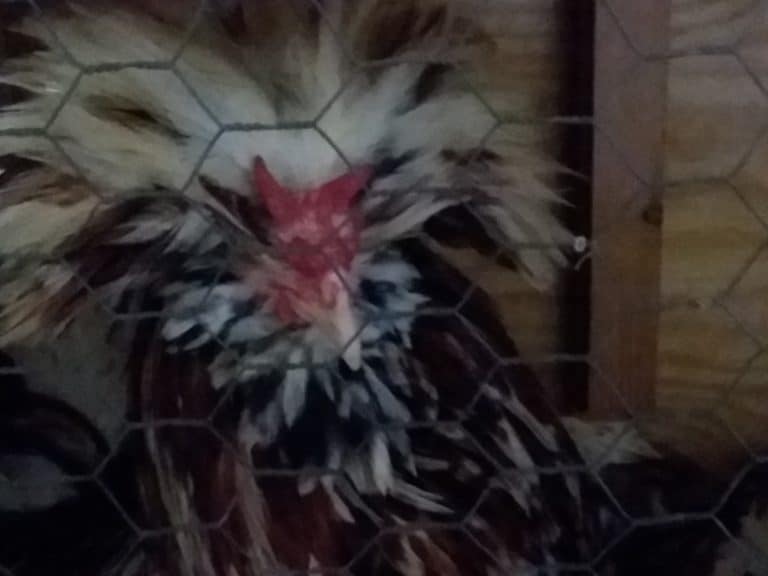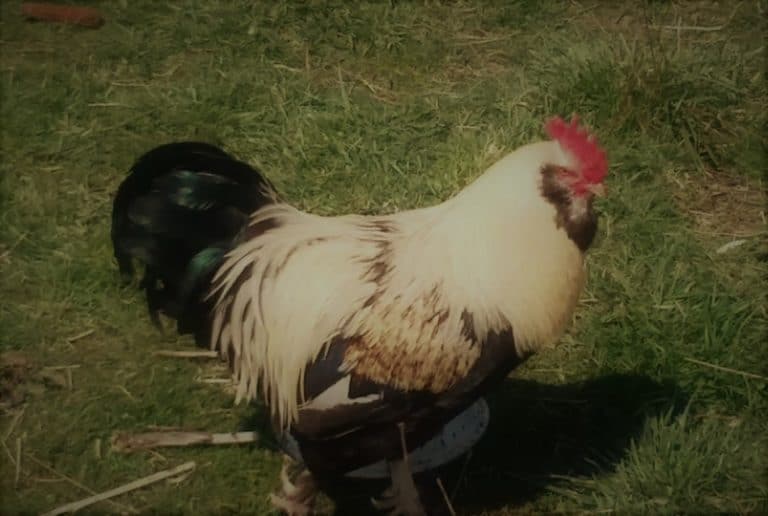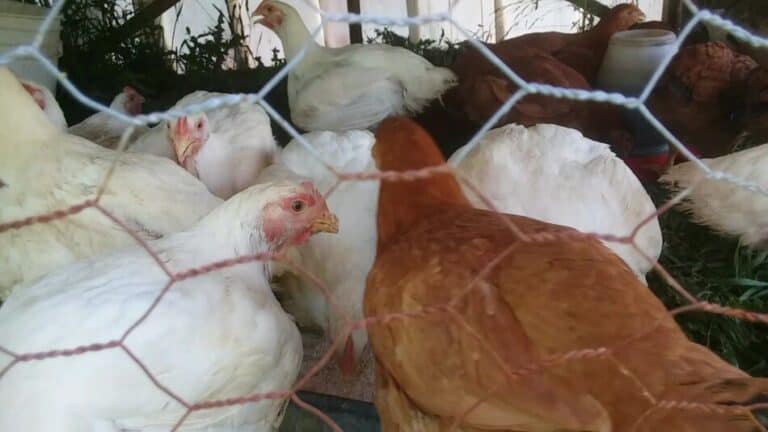What And How Much Do You Feed Egg Strain Pullets?
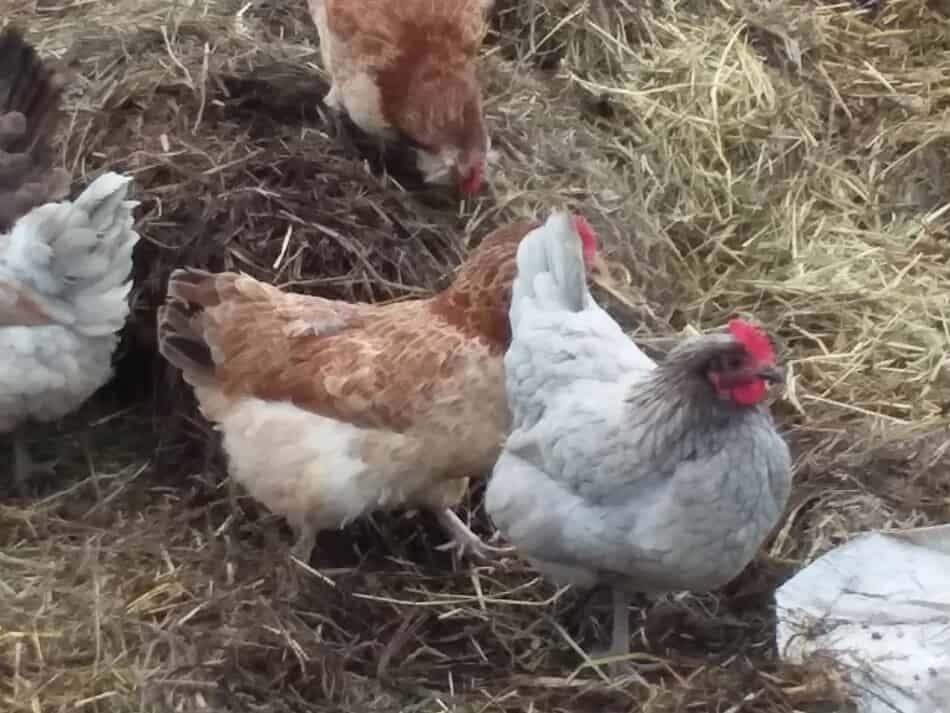
Getting started with raising your own chickens for eggs? Congratulations! Having your own eggs will give you a nice start into the world of raising your own food, plus the taste is unlike anything you can get at the store!
Now that you’ve decided to get your pullets, what should you be feeding them, how much feed will they need and what are the things they should not be eating?
Egg strain pullets should have free choice access to a ration formulated specifically for egg laying chickens, based on the age of the pullets. Day old pullets start on a 20% crumble and end up on a 16% laying mash when they start producing eggs.
I love having our own eggs! It’s great to find a nice, newly laid egg in a little hen built nest. We have a variety pack of chickens, so you never know what color egg will be under than hen!
Is Raising Chickens For Eggs Worth It? will walk you through the costs of raising and feeding your egg producing flock.
We let our chickens run loose and are very casual about egg production. If you are wanting top production from your birds, you’ll need to have a nice area set up with egg boxes and all they can eat laying mash.
Since these are egg strain pullets, once they get close to laying age, let the gathering begin! You’ll get quiet a few eggs from those little hens!
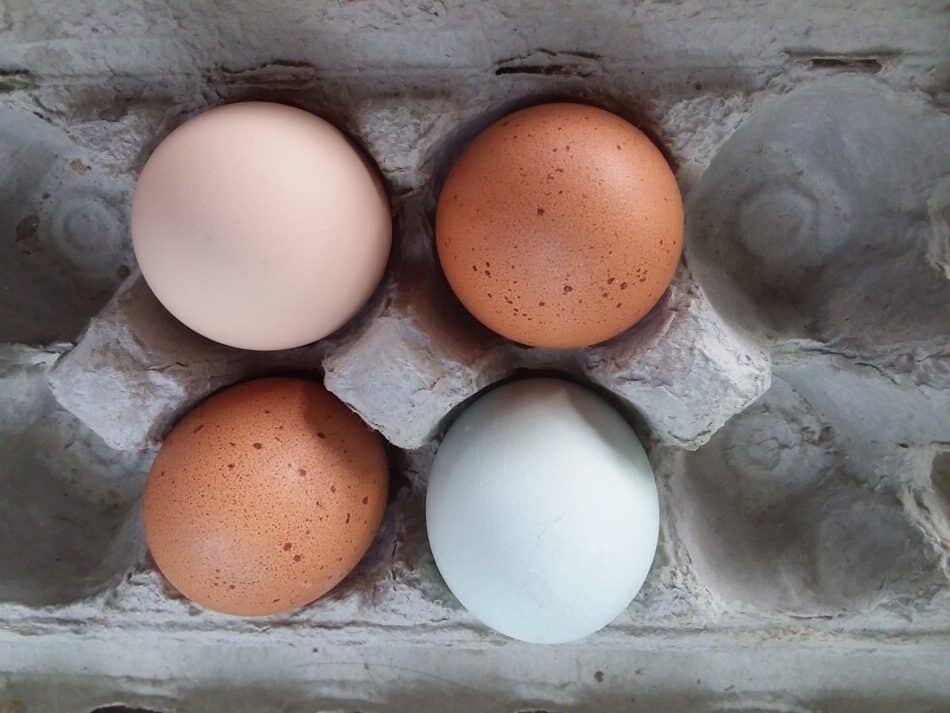
What do pullets eat?
Pullets are going to be fed a grain based mix that is from 20-16% protein, depending upon the age of the pullets. As the pullets grow, their protein needs decrease, necessitating a change in the ration.
| Age of pullet | Protein % | Type | Reason fed |
| 0-8 weeks | 20 | crumble | crumbles easy for chicks to eat, high protein to support growth |
| 8-16 weeks | 16 | ground or pellet | lower in protein to support mid stage growth needs |
| 16+ weeks | 16 | ground or pellet | layer mash is high calcium, which is needed for strong egg shells |
Why Feed Laying Mash? will go over the importance of laying mash vs regular chicken feed. We notice a huge difference in production when we switch the hens to laying mash.
Pullet rations are made from grain, usually corn and soybean meal
Around here, the most commonly used grains in a chicken ration would be corn and soybean meal with a mineral mix added. The base grains for your ration will vary by area, it might be barley, millet, wheat, etc.
Don’t get too worried about which grain is being used, it doesn’t matter to your chickens, as long as you have the protein percentage needed for your birds.
Feeds are formulated to meet specific requirements based on the needs of the animal that will be eating the ration. Just like there are lots of good choices for your lunch, there are lots of good choices of grains for pullet feed.
One of the reasons why chickens are popular all over the world is that chickens are adaptable and can eat many different sources of feed, so use the grains that are normal in your area.
Pullets should get free choice feed, water and grit
Your pullets should have free choice feed access. This means they can eat whenever they want and however much they want. Having plenty of feed available will help your birds grow, because it reduces competition at the feeders.
Of course, will feed being available all day, that means you should have clean, fresh water available all day, as well.
Additionally, if you are not aware of it, chickens do not chew their food! The just gulp it down and rely on grit in their digestive crop to grind up the food for them. Chickens Need Grit will show you why your pullets need grit.
Pullets should not get feed formulated for other poultry
Pullets should not be fed:
- all flock feeds
- multi livestock feeds
- adult chicken feeds
- broiler feed
These feeds on the “do not feed list” are formulated to suit birds with different nutritional needs than your pullets. To have productive egg layers, you need to raise your pullets on the nutrients they require.
The “one feed for everything” rations are becoming more popular in the feed store. I can see why! Before you buy, look carefully at the label and see if the bag specifically lists out pullets that are the same age as yours.
Maybe you get lucky and one of the above feeds happens to meet the requirements for your pullets at their current age. You can use the feed, as long as you carefully read the bag, first.
Pullets can eat bugs and grass
Once your pullets are out of the brooder, they can be put in outside pens or chicken tractors to eat bugs and grass, just like older chickens.
Pullets will need a base diet of grain, they can not grow well on grass or other foraging alone. Chickens love to eat grass and bugs, but can not grow well without some grain, as well.
Its’s a good idea to keep the pullets in their own pen until they are full size, just to keep your other birds from hogging all the feed!
If your pullets are the only birds you have, the feed part is easy, however you’ll still want to keep them in a chicken tractor rather than just letting them loose, until they get a bit bigger and are more predator resistant.
Laying breed pullets will eat 11.36 pounds of feed by 16 weeks
The total amount of feed each egg strain pullet will eat to get to laying age is 11.36 pounds of feed each.
If you are interested in the feed consumption for your pullets, here’s a nice chart that breaks down the feed usage per pullet per week.
The main point of the chart is that each pullet will eat nearly 11.5 pounds of feed (11.36, to be exact) to get to egg laying age.
The reason why this chart is useful it to help you plan your feed purchases!
If you have 10 pullets that are 14 weeks old, you know you’ll need to have 1 pound of feed per pullet for the week, which is 10 pounds of feed per week.
Now, you can figure up how much feed you have left in your bag and know if you need another bag of this feed to get your gals through for another few weeks until laying starts and you switch over the ration to a high calcium feed.
Growth and feed consumption chart
| Age in Weeks | Avg. Weight in Pounds | Feed/Week in Pounds | Consumption to Date in Pounds |
| 1 | .16 | .20 | .20 |
| 2 | .26 | .24 | .44 |
| 3 | .41 | .30 | .74 |
| 4 | .58 | .43 | 1.17 |
| 5 | .77 | .58 | 1.75 |
| 6 | .96 | .59 | 2.34 |
| 7 | 1.13 | .68 | 3.02 |
| 8 | 1.29 | .70 | 3.72 |
| 9 | 1.59 | .77 | 4.68 |
| 10 | 1.76 | .82 | 5.50 |
| 11 | 1.93 | .86 | 6.36 |
| 12 | 2.12 | .91 | 7.27 |
| 13 | 2.29 | .95 | 8.22 |
| 14 | 2.48 | 1.00 | 9.22 |
| 15 | 2.67 | 1.05 | 10.27 |
| 16 | 2.88 | 1.09 | 11.36 |
The chart only goes to 16 weeks since some of the earlier maturing egg layers will be starting to lay at this time. Most breeds of chickens will begin laying by 20 weeks.
Laying chicken feed is completely different from broiler feed
Pullets need feed formulated for egg strain chickens, not broiler feed!
As mentioned above, be sure you are using a feed that is appropriate for the pullets you have. This chart is based off of the growth and feed consumption of egg strain pullets, not traditional breed chickens and certainly not broilers!
Traditional breed chickens, like dual purpose breeds, will be a bigger bird that will eat more feed and weigh more at 16 weeks.
This chart will give you a good idea of feed consumption for traditional chicken breeds, just plan to feed slightly more than listed above, since you are feeding bigger pullets.
Broilers are a whole different deal, they end up eating over twice the feed in less than 8 weeks! And, of course, they will weigh more when they are finished!
If you are raising layers and broiler chicks at the same time, split the brooder. The broilers must have broiler feed to grow well! If you can’t split the brooder, feed all chicks the broiler ration and move out the laying pullets when you can.
How to Switch to a Chicken Laying Mash is an article by Patrick Biggs, Ph. D, giving more specifics on switching your pullet ration. You’ll definitely want to move to a layer mash right before eggs laying starts, to get strong egg shells.
Resources:
This chart (growth and feed consumption) is rewritten from the “Estimated Growth and Feed Consumption for Egg Strain Pullets” chart in the 2018 Meyer Hatchery Catalog, paper copy
